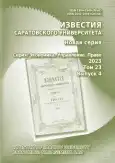Artificial intelligence technologies: Classification, limitations, prospects and threats
- Authors: Veshneva I.V.1
-
Affiliations:
- Saratov State University
- Issue: Vol 23, No 4 (2023)
- Pages: 428-438
- Section: Articles
- URL: https://journals.rcsi.science/1994-2540/article/view/251980
- DOI: https://doi.org/10.18500/1994-2540-2023-23-4-428-438
- EDN: https://elibrary.ru/XCKAXR
- ID: 251980
Cite item
Full Text
Abstract
About the authors
Irina Vladimirovna Veshneva
Saratov State University410028, Russia, Saratov, Astrakhanskaya str., 83
References
- Искусственный интеллект // Министерство цифрового развития, связи и массовых коммуникаций. URL: https://digital.gov.ru/ru/activity/directions/1046/ (дата обращения: 24.03.2023).
- АНО «Цифровая экономика» изучила лучшие практики внедрения ИИ в российскую обрабатывающую промышленность. URL: https://data-economy.ru/news/tpost/zfbdovnco1-ano-tsifrovaya-ekonomikaizuchila-luchsh (дата обращения: 24.03.2023).
- The Socio-Economic Impact of AI in Healthcare. URL: https://www.medtecheurope.org/wp-content/uploads/2020/10/mte-ai_impact-in-healthcare_oct2020_report.pdf (дата обращения: 24.03.2023).
- Haseeb M., Mihardjo L. W., Gill A. R., Jermsittiparsert K. Economic impact of artificial intelligence: New look for the macroeconomic assessment in Asia-Pacifi c region // International Journal of Computftional Intelligence Systems. 2019. Vol. 12, iss. 2. P. 1295–1320. https://doi.org/10.2991/ijcis.d.191025.001
- Van Roy V. AI Watch – National strategies on Artificial Intelligence: A European perspective in 2019 // EUR 30102 EN, Publications Office of the European Union, Luxembourg, https://doi.org/10.2760/602843 , JRC119974
- Review of Artificial Intelligence and Machine Learning Technologies: Classifi cation, Restrictions, Opportunities and Challenges // Mathematics, MDPI. 2022. Vol. 10, iss. 15. P. 1–25. https://dx.doi.org/10.3390/math10152552
- Аверкин А. Н., Гаазе-Рапопорт М. Г., Поспелов Д. А. Толковый словарь по искусственному интеллекту. М. : Радио и связь, 1992. 256 с.
- Ивахненко А. Г. Самообучающиеся системы с положительными обратными связями. Киев : Изд-во АН УССР, 1963. 330 с.
- Вешнева И. В., Сингатулин Р. А. Разработка информационно-образовательных комплексов системы дистанционного обучения с обратной связью на основе фотограмметрических методов и статусных функций. Часть 2 // Вестник Саратовского государственного технического университета. 2015. Т. 3, № 1 (80). С. 125–132. EDN: VKUGQB
- Вешнева И. В. Математические модели в системе управления качеством высшего образования с использованием методов нечеткой логики. Саратов : Саратовский источник, 2010. 186 с.
- Bolshakov A. A., Veshneva I. V. Assessment of the Effectiveness of Decision Support in the Application of the Information System for Monitoring the Process of Forming Competences Based on Status Functions // 2018 International Conference on Actual Problems of Electron Devices Engineering (APEDE). Saratov, Russia, 2018. P. 75–82. https://doi.org/10.1109/APEDE.2018.8542462
- Заставь машину думать: как развивают искусственный интеллект у роботов // РБК. URL: https://trends.rbc.ru/trends/innovation/5d6520ea9a79474acef15b63 (дата обращения: 24.03.2023)
- Islas-Cota E., Gutierrez-Garcia J. O., Acosta C. O., Rodríguez L. F. A systematic review of intelligent assistants // Future Generation Computer Systems. 2022. Vol. 128. P. 45–62. https://doi.org/10.1016/j.future.2021.09.035
- Krinkin K., Shichkina Y., Ignatyev A. Co-evolutionary hybrid intelligence // 2021 5th Scientific School Dynamics of Complex Networks and their Applications (DCNA). Kaliningrad, Russian Federation. 2021. P. 112–115, https://doi.org/10.1109/DCNA53427.2021.9587002
- Созданный в США робот пообещал уничтожить человечество. URL: https://rg.ru/2016/03/22/robotpoobeshchal-unichtozhit-chelovechestvo.html (дата обращения: 24.03.2023).
- Veshneva I. V., Bolshakov A. A. Construction of Digital Twins of Socio-Economic Systems Using Mathematical Models Based on Status Functions // Society 5.0: HumanCentered Society Challenges and Solutions. Cham : Springer, 2022. P. 129–141. https://doi.org/10.1007/978-3-030-95112-2_11
- Bolshakov A., Veshneva I., Lushin D. Mathematical Model of Integration of Cyber-Physical Systems for Solving Problems of Increasing the Competitiveness of the Regions of the Russian Federation // Society 5.0: Cyberspace for Advanced Human-Centered Society. Cham : Springer Verlag, 2021. P. 129–139. https://doi.org/10.1007/978-3-030-63563-3_11
- Veshneva I., Chernyshova G., Bolshakov A. Regional Competitiveness Research Based on Digital Models Using Kolmogorov-Chapman Equations // Society 5.0: Cyberspace for Advanced Human-Centered Society. Cham : Springer Verlag, 2021. P. 141–154. https://doi.org/10.1007/978-3-030-63563-3_12
- Перспективы развития // РОССЕТИ. Стратегический отчет. URL: http://rosseti14.kerrygun.ru/strategicreport/prospects-of-development (дата обращения: 24.03.2023).
- Investment in Artificial Intelligence Solutions Will Accelerate as Businesses Seek Insights, Efficiency, and Innovation, According to a New IDC Spending Guide // International Data Corporation. 2021. URL: https://idc.com/getdoc.jsp?containerId=prUS48191221 (дата обращения: 24.03.2023).
- Княгинин В. Н., Липецкая М. С., Санатов Д. В., Васеев И. Е., Годунова Е. А., Семенова М. А., Харитонов М. А., Холоднова Е. М. Искусственный интеллект в промышленности. Экспертно-аналитический доклад. URL: https://csr-nw.ru/upload/iblock/3db/Доклад%20по%20ИИ%20в%20промышленности_финал.pdf (дата обращения: 24.03.2023).
- Чернышова Г. Ю., Вешнева И. В., Роках Г. Е. Моделирование динамики рисков региональной конкурентоспособности // Известия Саратовского университета. Новая серия. Серия: Экономика. Управление. Право. 2022. Т. 22, вып. 1. С. 42−52. https://doi.org/10.18500/1994-2540-2022-22-1-42-52
- Samuelson P., Scotchmer S. The Law and Economics of Reverse Engineering // The Yale Law Journal. 2002. Vol. 111, no. 7. P. 1575−1663. https://doi.org/10.2307/797533
- Shenkar O., Oded Shenkar, Yadong Luo. International business. Hoboken, N. J. : Wiley, 2004. 513, [217] р.
- Strubell E., Ganesh A., McCallum A. Energy and Policy Considerations for Deep Learning in NLP // Proceedings of the 57th Annual Meeting of the Association for Computational Linguistics. Florence, Italy, 2019. P. 3645–3650. URL: https://arxiv.org/pdf/1906.02243.pdf (дата обращения: 24.03.2023).
- Сбер представил открытый инструмент для оценки углеродного следа моделей ИИ // Lenta.Ru. URL: https://lenta.ru/news/2022/06/17/openinstr/ (дата обращения: 24.03.2023).
- Широковских С. А. Возможности, ограничения и вероятные угрозы устойчивому развитию высокотехнологических компаний азиатского региона вследствие выхода из-под контроля искусственного интеллекта и нейросетей // Экономика Центральной Азии. 2020. Т. 4, № 4. С. 385−394. https://doi.org/10.18334/asia.4.4.111626
Supplementary files









